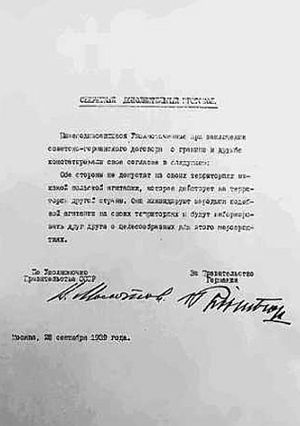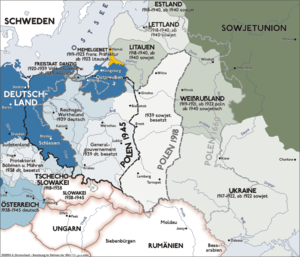- Gestapo–NKVD Conferences
-
The Gestapo–NKVD conferences were a series of meetings organized in late 1939[1][2] and early 1940, whose purpose was the mutual cooperation between Nazi Germany and Soviet Union. In spite of several differences, both Heinrich Himmler and Lavrentiy Beria had common purposes as far as the fate of Poland was concerned[3], and the conferences discussed coordinating plans for occupation of the Polish nation and in fighting the Polish resistance movement[4][5], which was an irritant to both Nazi and Soviet occupiers of Poland.
Out of four conferences[4], the third took place in the famous Tatra Mountains spa of Zakopane[1] in Poland, and is the most remembered (the Zakopane Conference). From the Soviet side, several officers of the NKVD participated in these meetings, and the Germans brought a group of experts from the Gestapo.
Contents
Prelude
In 1939, after the signing of the Ribbentrop-Molotov Pact in August, the German invasion of Poland on 1 September[6][7] and Soviet invasion of Poland on 17 September[6][8] resulted in the country being occupied by the Soviet Union and Nazi Germany.
First Conference
Little is known about this meeting. It reportedly took place on September 27, 1939 in Brzesc nad Bugiem, while some units of the Polish Army were still fighting (see: Invasion of Poland). As both sides correctly expected that Polish resistance would start soon, they discussed ways of dealing with the possible activities of such resistance[2].
Second Conference
It took place some time at the end of November 1939, probably in Przemyśl[2] — a city which—between September 1939 and June 1941—was divided into two parts, German and Soviet. Apart from talks of fighting Polish resistance, the Soviets and the Germans discussed ways of exchanging Polish POWs. Also, first discussions about the occupation of Poland were started. Some historians claim this meeting took place in Lviv.[1][3] It is also claimed a meeting was held in December.[5][9]
 Secret protocol of German–Soviet Boundary and Friendship Treaty "Both parties will tolerate in their territories no Polish agitation which affects the territories of the other party. They will suppress in their territories all beginnings of such agitation and inform each other concerning suitable measures for this purpose."
Secret protocol of German–Soviet Boundary and Friendship Treaty "Both parties will tolerate in their territories no Polish agitation which affects the territories of the other party. They will suppress in their territories all beginnings of such agitation and inform each other concerning suitable measures for this purpose."
Third Conference
This one is the best known, and took place in Zakopane,[10] starting on February 20, 1940[5] in the villa "Pan Tadeusz", located on the road from Zakopane to Białka Tatrzańska. The German side was represented by Adolf Eichmann and an official by the name of Zimmermann, who later became chief of the Radom District of the General Government. The Soviets brought—among others—Rita Zimmerman (director of a gold mine in Kolyma) and a man named Eichmans, creator of an efficient way of killing in the back of the head[2].
According to several sources, one of the effects of this conference was the German ''Ausserordentliche Befriedungsaktion (see: German AB Action operation in Poland),[11] elimination of Krakow inteligentia Sonderaktion Krakau and the Soviet Katyn massacre[5][12] (a number of historians, including Norman Davies, claim that these two events were carried out cooperatively). This is disputed by numerous historians (see below).
News about the conference must have leaked out to Great Britain[citation needed], but London did not seem to care, which was immediately noticed by Joseph Stalin. Also, most probably in Zakopane, the Germans rejected suggestions of the Soviets to take over Polish officers, which sealed their fate. On March 5, 1940, in Moscow, the decision was made to murder them.[2]
In his 1991 book Stalin: Breaker of Nations, British historian Robert Conquest stated: "Terminal horror suffered by so many millions of innocent Jewish, Slavic, and other European peoples as a result of this meeting of evil minds is an indelible stain on the history and integrity of Western civilization, with all of its humanitarian pretensions". Also, professor George Watson from Cambridge University concluded in his "Rehearsal for the Holocaust?" Commentary (June 1981) that the fate of the interned Polish officers may have been decided at this conference.[13][14]
Both Russian and Polish historians dispute the connection between the German-Soviet meetings and the Katyn massacre. They point out that there is no documentary evidence confirming any cooperation on that issue, that the existing Soviet documentation actually makes such a cooperation improbable and that it is reasonable to say that Germany did not know about the Katyn massacre until the corpses were found. Specifically, historian Oleg Vishlyov points out that the alleged third conference in Zakopane in 1940 is not proven by any known German or Soviet documents and its description is only based on Bor-Komorowski's claims.[15]
Fourth Conference
The fourth and last meeting took place in March 1940 in Krakow[16][17] (according to some historians, it was part of the Zakopane Conference). This event was described by General Tadeusz Bór-Komorowski, commander of Armia Krajowa in his book “Armia Podziemna” (“The Secret Army”). In it, he describes how a special delegation of NKVD came to Krakow, which was going to discuss with Gestapo how to act against the Polish resistance. The talks lasted for several weeks.[18][19]
One of the ways of fighting Polish organized resistance in the German occupied General Government was creation of communist organizations (such as "Hammer and Sickle" or "Association of Friends of Soviet Union"), overseen by Moscow. Left-wing activists were cooperating with the NKVD, passing to them information about Polish patriotic groups. The Soviets then handed these reports to the Gestapo[citation needed].
Bor-Komorowski′s description is disputed by Russian historian Oleg Vishlyov, who, based on the original Soviet documents, points out that the conference was not between NKVD and Gestapo, but between Soviet and German commissions dealing with refugees. The topic of discussion was refugee exchange. The conference has nothing to do with repressions against Poles or with the Katyn massacre.[20] In fact, numerous historians point out that there is no evidence of German-Soviet cooperation in the Katyn massacre.[21]
- ^ a b c http://www.electronicmuseum.ca/Poland-WW2/soviet_deportations/soviet_deportations_album_1.html
- ^ a b c d e http://www.voskresenie.niedziela.pl/artykul.php?lg=ru&nr=200409&dz=z_historii&id_art=00005
- ^ a b Rees, Laurence (2008) World War Two Behind Closed Doors BBC Books ISBN 978-0-56-349335-8
- ^ a b http://www.communistcrimes.org/en/Database/Poland/Historical-Overview/1939-1941
- ^ a b c d http://www.electronicmuseum.ca/Poland-WW2/ethnic_minorities_occupation/jews_foreword.html
- ^ a b Zaloga, S.J. (2003) Poland 1939 Osprey ISBN 1 84176 408 6
- ^ http://www.thehistorychannel.co.uk/site/this_day_in_history/this_day_September_1.php
- ^ Davies, N. (1986) God's Playground Volume II Oxford University Press ISBN 0-19-821944-X Page 437
- ^ http://www.polandsholocaust.org/1939.html
- ^ http://www.warsawuprising.com/paper/jankowski1.htm
- ^ http://www.mp.gov.si/fileadmin/mp.gov.si/pageuploads/2005/PDF/publikacije/Crimes_committed_by_Totalitarian_Regimes.pdf
- ^ Conquest, Robert (1991). Stalin: Breaker of Nations Phoenix ISBN 1-84212-439-0 Page 229
- ^ Louis Robert Coatney. The Katyn Massacre
- ^ George Watson. Rehearsal for the Holocaust?
- ^ See e.g. Slawomir Kalbarczyk, "Zbrodnia Katynska po 70 latach: krotki przeglad ustalen historiografii" (in Zbrodnia Katynska. W kregu prawdy i klamstwa, IPN, Warszawa, 2010, pp. 18-19); Witold Wasilewski, "Współpraca sowiecko-niemiecka a zbrodnia katyńska" in Pamięć i Sprawiedliwość, 2009, nr.1.; О.В. Вишлёв, Накануне 22 июня 1941 года, М.: Наука, 2001, с.119-123; N. Lebedeva, A. Cienciala, W. Materski, Katyn: a crime without punishment, Yale University Press, 2007, p. 143.
- ^ Stenton, M. Radio London and Resistance in Occupied Europe Oxford,2000 ISBN 978-0198208433 page 277
- ^ http://memorial.kiev.ua/expo/eng/1939.html
- ^ Bór-Komorowski, T. (1950). The Secret Army Victor Gollancz Page 46
- ^ http://www.eesti.ca/?op=article&articleid=24922
- ^ О.В. Вишлёв, Накануне 22 июня 1941 года, М.: Наука, 2001, с.119-123.
- ^ See e.g. Slawomir Kalbarczyk, "Zbrodnia Katynska po 70 latach: krotki przeglad ustalen historiografii" (in Zbrodnia Katynska. W kregu prawdy i klamstwa, IPN, Warszawa, 2010, pp. 18-19); Witold Wasilewski, "Współpraca sowiecko-niemiecka a zbrodnia katyńska" in Pamięć i Sprawiedliwość, 2009, nr.1.; N. Lebedeva, A. Cienciala, W. Materski, Katyn: a crime without punishment, Yale University Press, 2007, p. 143.
Further reading
- Bor-Komorowski, Tadeusz (1951). "The Secret Army". New York, N.Y.: Macmillan. OCLC: 1524738
Prior antagonism Political Relations before 1941 · Molotov–Ribbentrop Pact (negotiations) · Boundary and Friendship Treaty · Population transfers · Axis talks · Gestapo–NKVD ConferencesEconomic Military Invasion of Poland · Soviet invasion of Poland · Occupation of the Baltic states · Winter War · Soviet occupation of Bessarabia and Northern Bukovina · Naval cruiser Lützow · Soviet offensive plans controversy · Basis Nord · Komet Northern Sea Route Raid · German–Soviet military parade in Brest-LitovskAftermath Operation Barbarossa · Eastern Front · Katyń massacre controversy · Falsifiers of History · Baltic WayCategoryCategories:- History of Poland (1939–1945)
- World War II conferences
- Germany–Poland relations
- Poland–Soviet Union relations
- Germany–Soviet Union relations
- NKVD
- 1939 conferences
- 1939 in international relations
Wikimedia Foundation. 2010.


